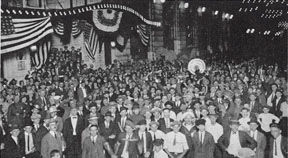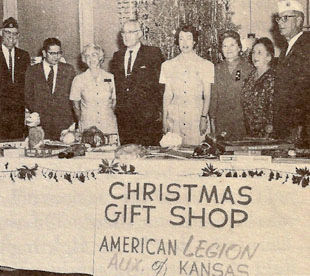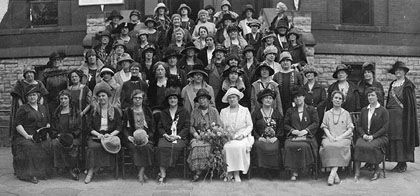

KANSAS AUXILIARY HISTORY
For nearly every man in World War I who endured the dangers and hardships of camp, shore and battlefront, there was a woman serving at home to help make possible America's victory -- his wife, mother, sister, daughter or granddaughter.
The war was won, and the men and women of the armed forces banded together in the American Legion to carry forward their services to the country in peacetime. It was only natural that the women of their families should desire to continue to serve with them. The result was the American Legion Auxiliary, the largest and most influential women's organization of its kind in the world today.
The establishment of an Auxiliary to The American Legion was provided for by the first National Convention of The American Legion in 1919. By the time of the 1920 National Convention, 1,342 local Units of this Auxiliary had been formed nationwide. The first National Convention of the Auxiliary was held in Kansas City, Missouri, in 1921. At that time the name "American Legion Auxiliary" was adopted and the first national officers elected. The idea of a women's auxiliary dated back almost to the founding of the Legion itself. Several feminine groups which had aided in the homefront war effort sought recognition from the Minneapolis convention in 1919. The National Military Sisterhood of America, whose national president was Mrs. Charles Martin, wife of the Adjutant General of Kansas, had been successful in obtaining the endorsement of the Kansas Department, but it was not so fortunate at Minneapolis. Rather than risk alienating other groups by adopting one, the convention decided that the Legion should organize its own auxiliary. This was accomplished on a local level by the time of the Cleveland Convention (1920), and the various departments were organized enough to send delegates to the Kansas City Convention (1921).
Frank Samuel, the Department Adjutant, had carried out the initial formation of the Auxiliary in Kansas. Thomas A. Lee, while Department Commander, called the first Auxiliary convention in Newton, January 10-11, 1921. There permanent organization was completed, a constitution similar to that of the Legion was drawn up, and the aims of rehabilitation of disabled veterans, child welfare activities, betterment of the local community, and patriotism were decided upon. Mrs. Winifred Calihan, Garden City, was the first President of the Kansas Auxiliary, and the department office was set up in the Topeka office of The American Legion. The two organizations have shared quarters form that time to the present. Miss Izetta McCoy was appointed Department Secretary in February, 1921 but resigned nine months later to become the National Treasurer. Miss McCoy was followed by Miss Emma Hadorn who served until 1925.
Membership was open to the wives, mothers, sisters and daughters of Legionnaires (that has since been expanded to women of direct lineage to those who have served during the eligibility period). Close female relatives of those who had lost their lives during World War I were also eligible, not only to membership in the Auxiliary, but also to the exclusive Order of the Gold Star. In the first year of its existence, the Auxiliary in Kansas had 181 units, while the second year saw it grow to 253 units. An Auxiliary unit had to be associated with a Legion post, but a post did not necessarily have to have an Auxiliary unit. Nevertheless, the Kansas Auxiliary took as its rallying cry the slogan "No bachelor posts!" meaning that every post should have an auxiliary. In selecting rehabilitation as one of its aims, the Auxiliary was following the lead of The American Legion.
The interest of both the Legion and the Auxiliary in the youth of the nation had flowed from the interest of both organizations in the children of their own members. Since eligibility was given to the sisters and daughters of World War I veterans, this meant that some of the members of the Auxiliary could be very young in terms of years from the very beginning of the organization. Some, daughters particularly, were enrolled at birth, and became members of the "Cradle Roll." By the third decade of the Thirties, many of these girls were old enough to become interested in the activities of the Auxiliary, but were still not old enough to partake in them at an adult level. In 1934 the Auxiliary amended its constitution to divide the Auxiliary into two main classes, with eighteen being the dividing line. Those eighteen and over were senior members, those under were juniors.
The American Legion Auxiliary Department of Kansas has enjoyed a strong and vibrant membership since initiating its charter in 1921. Peaking at over 31,000 members in 1971, the women of the Department of Kansas continue to focus on growing its numbers and expanding its ranks while working the mission of supporting veterans, active duty service members and their families.



